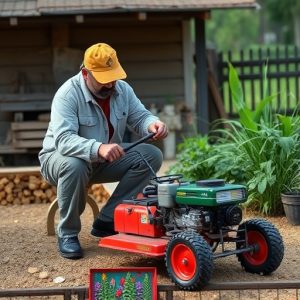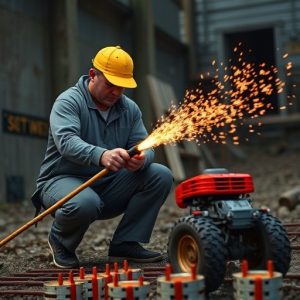Mastering Self-Defense with the Kubotan: A Comprehensive Guide on Its Use and Techniques
The Kubotan is a versatile self-defense tool modeled after a pen, which martial artists can skillfu…….
The Kubotan is a versatile self-defense tool modeled after a pen, which martial artists can skillfully integrate into their training for enhanced precision and power in strikes. Its effectiveness lies in its ability to simulate larger impact weapons and serves as an ideal tool for close-quarters combat, where it can be used to incapacitate an attacker or maintain distance until help arrives. Mastery of the Kubotan is achieved through specialized training that covers various grips and strikes, leveraging the device's control and leverage to defend against grabs and holds. It's crucial for practitioners to learn the correct techniques within their martial arts style, such as karate or kung fu, and understand its use beyond just a weapon—as a means to control an attacker and enhance overall self-defense skills. The Kubotan's small size allows for discreet carry, making it a practical choice for personal protection in potentially dangerous situations. How to use a kubotan effectively involves integrating this tool into one's training, practicing scenario-based drills, and focusing on precision application to neutralize threats without resorting to lethal force. Regular sparring with a trained partner is key to refining these skills for real-life defense scenarios where swift and accurate response is critical.
Exploring the dynamic realm of self-defense, this article delves into the art of Kubotan training. Originating from the potent strikes of Karate, the Kubotan has evolved into a sophisticated self-defense tool, offering practitioners a versatile means to enhance their martial arts skills. Whether you’re new to the discipline or looking to refine your techniques, understanding how to use a Kubotan effectively is paramount. We will guide you through the historical roots of this instrument, the core principles that underpin its use, and the advanced maneuvers that elevate it beyond a mere accessory into an integral part of your self-defense repertoire. Join us as we unravel the techniques and tactics that make Kubotan training a vital aspect of modern martial arts practice.
Understanding the Kubotan: A Versatile Self-Defense Tool for Effective Martial Arts Training
The Kubotan is an innovative self-defense tool that has gained prominence in martial arts training for its versatility and effectiveness. This small, pen-like device is a simple yet powerful addition to one’s self-defense arsenal. Its design allows users to practice techniques that mimic the use of larger impact weapons while being suitable for close-quarters combat. Training with a Kubotan enhances striking precision, enabling practitioners to deliver controlled, debilitating strikes to an attacker. It is particularly useful for self-defense scenarios where space and the potential for escalation are concerns. Understanding how to use a Kubotan involves mastering its applications in various martial arts styles, from karate to kung fu, where it complements traditional striking techniques with added control and leverage against an adversary.
To effectively wield the Kubotan, one must integrate it into their training regimen, focusing on the mechanics of each strike and its intended impact. This includes understanding the proper grip, angles for maximum effect, and the distinction between defensive maneuvers and offensive strikes. Proper instruction is paramount; under the guidance of an experienced instructor, individuals can learn to use the Kubotan to defend against grabs, holds, and attacks, while also practicing its use in conjunction with traditional empty-hand techniques. The Kubotan’s utility lies not only in its ability to inflict pain but also in its potential to create distance between oneself and an assailant, buying precious time to escape or neutralize a threat. Incorporating the Kubotan into one’s martial arts training can thus significantly enhance one’s self-defense capabilities.
The History and Development of the Kubotan: From Karate to Modern Self-Defense
The Kubotan, an innovative self-defense tool, has a rich history deeply rooted in the martial arts tradition, particularly within the realm of karate. Developed by sensei Frank Karszewski, better known as Frank Kubota, in the mid-20th century, this compact, pen-like device was initially designed to enhance the training of karate practitioners. Its introduction marked a significant evolution in martial arts practice, allowing for more effective self-defense techniques. The Kubotan’s design enabled users to simulate the impact of a longer weapon with precise control and precision, making it an ideal tool for honing striking skills without the complexity of managing a full-sized stick or baton.
Over time, the Kubotan’s utility expanded beyond mere training aid to become a versatile self-defense instrument. Its small size allows for easy concealment, making it accessible in situations where personal safety is threatened. The Kubotan’s effectiveness lies in its ability to extend the range and force of hand strikes, providing users with a means to defend against larger or stronger assailants. Incorporating the Kubotan into self-defense training involves learning how to use it in conjunction with traditional empty-hand techniques, creating a comprehensive personal protection system. Understanding how to effectively deploy the Kubotan requires dedicated practice and mastery of its unique applications, which can be learned through specialized training programs designed to enhance one’s defensive capabilities.
Key Principles in Kubotan Self-Defense Training: Techniques and Tactics
Kubotan self-defense training encompasses a range of techniques and tactics that leverage a short, thick stick known as a kubotan for personal protection. The kubotan is a versatile tool that can be used in various ways to neutralize threats. Central to effective use of the kubotan is understanding its application within the context of self-defense. Practitioners learn to control an attacker’s movements by applying pressure to key points on the body, such as nerves and joints, which can incapacitate an assailant without necessarily resorting to lethal force.
Mastery of how to use a kubotan involves mastering both offensive and defensive maneuvers. Defense training incorporates stances and movements that optimize the user’s balance and stance while minimizing the attacker’s ability to strike effectively. Offensive techniques include targeted strikes, disarms, and grappling maneuvers that exploit the vulnerabilities revealed by an opponent’s aggression. Incorporating the kubotan into one’s self-defense repertoire requires dedication to practice and a thorough understanding of its potential in a real-world conflict scenario. Training often includes drills that simulate confrontational situations, allowing practitioners to reflexively apply the techniques they have learned under pressure. This practical application ensures that individuals are prepared to respond effectively to threats using their kubotan for self-defense.
Mastering the Grip: Fundamental Holding Techniques for Maximizing Kubotan Effectiveness
Mastering the grip is paramount in effectively utilizing a Kubotan for self-defense training. The Kubotan, a short, dense stick, serves as an extension of the hand and finger tips, amplifying the force and precision of strikes when self-defense is necessary. To initiate proficiency with this tool, one must first understand the correct grip. Hold the Kubotan as if it were a pencil, with your fingers wrapped firmly around it, ensuring that your thumb is positioned on top for control and to prevent slipping. The grip should be neither too tight nor too loose; it should allow for fluid movement without compromising control. Practicing this hold regularly will enhance your muscle memory, enabling you to execute techniques confidently under stress.
Furthermore, advanced practitioners may explore different grips to adapt the Kubotan’s use to various self-defense scenarios. For instance, a reverse grip can be employed for techniques that require the flat side of the Kubotan to strike, or for control and restraint maneuvers. Additionally, some martial artists choose to hold the Kubotan at its midpoint to increase leverage when applying pressure points or joint locks. Regardless of the specific technique, consistent training and experimentation with different grips are essential to maximize the effectiveness of the Kubotan in self-defense situations. Knowledge of how to use a Kubotan effectively is not just about the mechanics of holding it; it’s also about understanding its potential applications and integrating it into your self-defense repertoire through dedicated practice.
Advanced Kubotan Maneuvers: Integrating the Tool into Your Martial Arts Repertoire
The Kubotan is an innovative self-defense tool that has gained popularity among martial artists for its versatility and effectiveness in various combat scenarios. When integrating the Kubotan into your martial arts repertoire, it’s crucial to understand how to use a kubotan effectively. Advanced practitioners often incorporate this training instrument into their practice to enhance their striking power and self-defense capabilities. The Kubotan’s design allows for precise pressure application and can be used in conjunction with traditional strikes to deliver controlled, powerful techniques that can incapacitate an opponent. Advanced maneuvers include using the Kubotan to control an assailant’s limbs, creating distance, or employing it as a distraction while executing follow-up strikes. Mastery of these advanced techniques requires dedicated training and an understanding of the biomechanics involved. Practitioners should focus on coordination, timing, and precision to effectively integrate the Kubotan into their martial arts discipline, ensuring they are prepared for self-defense situations where every second counts. Regular drills and sparring with a trained partner can help refine these skills, allowing practitioners to confidently use a kubotan as part of their defense strategy.


